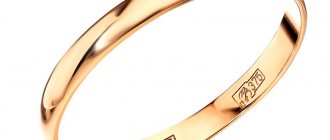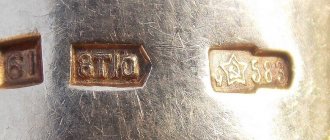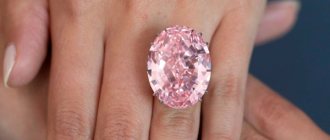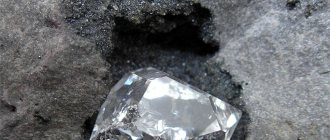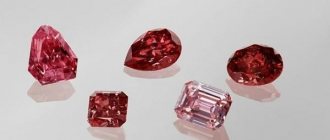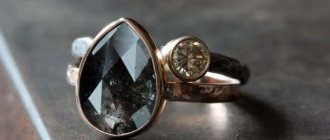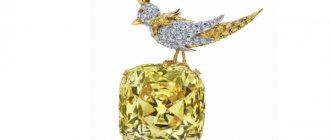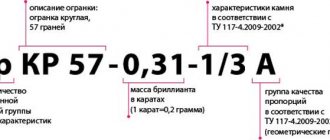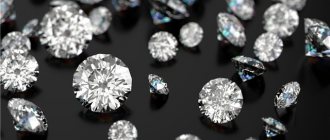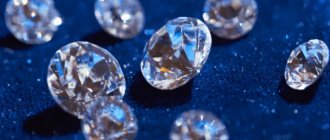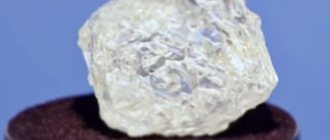History and description
“Shah” is not a diamond, since the gemstone does not have a characteristic cut. However, the diamond's edges are polished and have 3 inscriptions. The slightly yellowish mineral is an elongated octahedron weighing 88.7 carats. Its shape is far from ideal by jewelry standards, but its transparency is impeccable. The diamond does not have any inclusions, cracks or other defects.
The history of the stone originates from Indian mines. It was there in the 15th century. discovered this beautiful mineral. One of the first owners of the crystal was the Persian Sultan Burhan II. He ordered the first inscription to be made on the diamond. It is interesting that the master who was supposed to make the engraving found himself in a very difficult situation. After all, diamond has the highest hardness coefficient, it is impossible to scratch it. But the brilliant jeweler found a way out. He guessed that a diamond could be scratched with the same diamond. He collected diamond chips on the tip of the needle and patiently wrote on the stone an inscription, which translated from Persian meant “lord of order.”
However, a year later, the Mughal Shah Akbar, who seized the state of Burhan, appropriated the jewel for himself. He did not appreciate her beauty and sent the trophy to one of his many treasuries. The diamond lay there for several decades. Only the Shah's grandson Jihan remembered the Persian stone. By his decree, a second inscription was made on the crystal with the name and date of Jihan’s reign.
The stone became a dynastic regalia. The diamond was hung in the center of the canopy that adorned the throne of the Mughal rulers, which was also called the “Peacock Throne.” Now the stone was always in the Khan’s field of vision. A shallow groove was carved into its thin end so that the stone could sometimes be worn around the neck. This was recorded in the middle of the 17th century. made by a French merchant who was the first European to see the legendary diamond.
Soon the Mughal Empire fell into decline. Enemy states tore it apart. The diamond disappeared for a while. In the 18th century he ended up in Tehran in the treasury of Shah Fath Ali. In honor of the thirtieth anniversary of his reign, a third inscription was made on the stone.
Who owned the Finger of Allah diamond?
The main historical periods of diamond:
- from the middle of the 16th century to 1591 - Burhan II, Sultan of the province of Ahmednagar, India;
- from 1595 to 1739 - dynastic treasure of the Great Mughals;
- from 1739 to 1829 – kept by the padishahs of Persia;
- from 1829 to 1917 - the relic is transferred to the treasury of the Romanov imperial family;
- from 1917 to 1922 – the Moscow Kremlin, the jewel of the Soviet state;
- from 1922 to the present - one of the exhibits among the large precious stones of the Diamond Fund of the Moscow Kremlin.
Since ancient times, diamonds have been valued for their hardness, purity, and endow the owner with intelligence, courage and determination. But the yellowish diamond found in Golconda, due to the prejudices of the Indian rulers, was not in favor and was sold for a small price to the Ahmednagar Sultanate in the south of the Hindustan Peninsula.
The Muslim ruler Burhan II appreciated the diamond for its shape and attractive shine, and considered the color to be good luck, and named it “Finger of Allah.”
Vir for diplomats
The appearance of the famous stone in Russia is associated with tragic events. In the last days of January 1829, the embassy of the Russian Empire was destroyed in Tehran by a crowd of thousands of religious fanatics. 37 Russian diplomats were killed, among whom was the famous poet and statesman A. S. Griboyedov.
Shortly before this, the Turkmanchay Treaty was signed between Persia and the Russian Empire, under which the Persians had to pay a significant indemnity. Persian society greeted this agreement with discontent, which later resulted in a rebellion and the murder of Russian diplomats. This pogrom caused a huge diplomatic scandal. The Persian Shah sent his grandson Khozrev-Mirza to establish relations with Emperor Nicholas I. He brought with him rich gifts. In addition to the famous diamond there were:
- Kashmiri carpets;
- gold candelabra;
- rare ancient manuscripts;
- pearl necklaces;
- sabers and other weapons.
Nicholas I, flattered by the treasures, suggested forgetting the Tehran incident. Although many historians are inclined to believe that this is just a sad legend.
The stone was immediately examined by the leading orientalists of the time, who gave it the name "Shah". The jewel was later sent to the imperial treasury. For a long time the stone was kept in the Winter Palace.
After the civil war, it was taken to the Kremlin Armory, where Soviet academicians again studied the most beautiful crystal and compiled its description. During the difficult years of the formation of the new state, the Soviet government did not hesitate to sell former imperial treasures. However, the Persian gift, like most other historical precious stones, was preserved. Today, some of them can be admired at the Diamond Fund exhibitions in the Kremlin.
Characteristics of the Shah diamond
The treasure of the Diamond Fund of Russia, the Shah crystal has changed several rulers . The stone is 3 cm long, 1.5 cm wide, in the shape of an elongated octahedron. The weight of the 87-carat Shah diamond is 18 grams; before polishing it weighed 95 carats.
The uncut crystal was polished, and the owners engraved their names on it. It has a surrounding groove for a cord that was attached to the canopy of the Shah's throne.
A detailed description of the diamond was given by Professor Alexander Fersman, a mineralogist and crystallographer. In 1922, the scientist studied and characterized the jewelry of the Armory Chamber.
Interestingly, the octahedron is the shape of the classic diamond. When processed, it is divided into 2 parts along the middle fracture, and the 5-sided pyramids familiar in cross-section are obtained.
For reference: Unlike a classic diamond, the “Shah” has an oblong shape with rounded edges - in the schematic image it is a long diamond-shaped prism, the ends of which are blunt and look like pyramidal planes (domatic).
There are no typical middle breaks. Fersman identified 15 facets on the stone, 8 of which are natural, the rest from manual processing.
The ideal transparency of a diamond contributes to the shimmer of light and the play of all colors of the spectrum . The professor noted a yellowish tint, which is due to the structure of the surface layer. The diamond layers are cut through by scaly plates, reflected on the facets by thin arcs, as well as internal microcracks.
Diamond goes to the Persians
By 1739, tiny provinces remained of the Indian territories over which the Great Mughals reigned supreme. The Persian commander Nadir Shah reduced the areas of the state by sacking Delhi and seizing lands west of the Indus River (Sindh, Peshawar and Kabul).
It was he who took away the Peacock Throne and the Mughal treasury along with the Finger of Allah and Koh-i-Noor diamonds . The treasures of the Baburids were taken out on 21 camels: about 2 tons of gold, about 5 tons of diamonds, priceless emeralds and rubies. The pearls were loaded into the caravan without being counted or weighed.
In Persia, the trace of the Peacock Throne was lost with the death of Nadir Shah in 1747. Some claim that the relic was captured by the Kurds, dismantled and sold, other sources write that its parts were used to make Persian “peacock” thrones.
PHYSICAL PROPERTIES
| Mineral color | colorless, yellowish-brown fading to yellow, brown, black, blue, green or red, pink, cognac brown, blue, lilac (very rare) |
| Stroke color | no |
| Transparency | transparent, translucent, opaque |
| Shine | diamond, bold |
| Cleavage | octahedron perfect |
| Hardness (Mohs scale) | 10 |
| Kink | uneven |
| Strength | fragile |
| Density (measured) | 3.5 – 3.53 g/cm3 |
| Radioactivity (GRapi) | 0 |
| Thermal properties | High thermal conductivity. It feels cold to the touch, which is why diamonds are called “ice” in slang. |
Bibliography
- A. E. Fersman.
Crystallography of diamond / D. S. Belyankin, I. I. Shafranovsky. - Leningrad: Publishing House of the USSR Academy of Sciences, 1955. - P. 459. - 547 p. — 5000 copies. - A. E. Fersman.
Entertaining mineralogy / A. A. Kukharenko. - 4. - Leningrad: Children's literature, 1975. - 238 p. - N. I. Kornilov, Yu. P. Solodova.
Jewelry stones. - 2. - Moscow: Nedra, 1987. - 282 p. - V. A. Milashev.
Diamond. Legends and reality / A. N. Oleynikov. - 2. - Leningrad: Nedra, 1981. - P. 37. - 161 p. - A. K. Burtsev, T. V. Guskova.
Precious stones / Z. I. Edigaryan. - Moscow: Primat, 1992. - 128 p. - #
- Valaev R. G.
Novels about precious stones. — Radyansky writer, 1970. - Wikimedia Commons has media related to Shah (diamond)
How to distinguish amber from a fake
Today you can fake this polymer without even leaving your home. To create artificial stones, glass, plastic, various resins, natural stone chips and much more are used. But how do you understand that you are the owner of a natural gem? There are only a few simple ways:
The most important thing is that the weight of natural amber is very small, and therefore even massive jewelry will not weigh much. Glass or plastic will be significantly heavier
As a rule, you can feel this immediately if you pick up the product in your hands. A real stone will not be ideal in appearance. First of all, pay attention to the color - in a natural gem it is uneven, some areas are lightly painted, and some are more saturated. In addition, natural amber will shimmer in the sun, but the presence of sparkles inside should alert you: a natural gem simply cannot have them! It is known that amber, which is formed from the resin of coniferous plants, becomes electrified when rubbed. To check this, simply rub it with a piece of wool and bring a small sheet of paper or fluff to it - it will immediately attract them to itself. You can check its naturalness by immersing the stone in a strong saline solution. The imitation will immediately sink to the bottom of the glass, but the real one will remain floating on the surface of the water due to its low density. A natural gem will never be cheap, and therefore low cost is the first reason to refuse a purchase. Apply acetone or alcohol to the surface. The appearance of the natural stone will not change, but the fake will have a stain, a change in color, etc. Touch the stone with a hot needle. A natural gem emits a light pine aroma, but plastic will not smell very pleasant.
If you still doubt the authenticity of a gem, you can always turn to professionals. Using special equipment, they can easily determine whether what you have in front of you is fake or natural amber.
APPLICATION
Good crystals are cut and used in jewelry. About 15% of mined diamonds are considered jewelry, another 45% are considered near-jewelry, that is, inferior to jewelry in size, color or clarity. Currently, global diamond production is about 130 million carats per year. A diamond (from the French brillant - brilliant) is a diamond that, through mechanical processing (cutting), has been given a special shape, a brilliant cut, which maximizes the optical properties of the stone, such as brilliance and color dispersion. Very small diamonds and fragments, unsuitable for cutting, are used as an abrasive for the manufacture of diamond tools necessary for processing hard materials and cutting the diamonds themselves. The cryptocrystalline variety of diamond, black or dark gray in color, forming dense or porous aggregates, is called Carbonado, has a higher abrasion resistance than diamond crystals and is therefore especially valued in industry.
Small crystals are also grown artificially in large quantities. Synthetic diamonds are obtained from various carbon-containing substances, mainly from graphite, in special. apparatuses at 1200-1600°C and pressures of 4.5-8.0 GPa in the presence of Fe, Co, Cr, Mn or their alloys. They are suitable for technical use only.
Diamond - C
| Molecular weight | 12.01 g/mol |
| origin of name | From Greek, adamas, meaning "invincible" or "solid". |
| IMA status | valid, first described before 1959 (before IMA) |
Bibliography
- A. E. Fersman.
Crystallography of diamond / D. S. Belyankin, I. I. Shafranovsky. - Leningrad: Publishing House of the USSR Academy of Sciences, 1955. - P. 459. - 547 p. — 5000 copies. - A. E. Fersman.
Entertaining mineralogy / A. A. Kukharenko. - 4. - Leningrad: Children's literature, 1975. - 238 p. - N. I. Kornilov, Yu. P. Solodova.
Jewelry stones. - 2. - Moscow: Nedra, 1987. - 282 p. - V. A. Milashev.
Diamond. Legends and reality / A. N. Oleynikov. - 2. - Leningrad: Nedra, 1981. - P. 37. - 161 p. - A. K. Burtsev, T. V. Guskova.
Precious stones / Z. I. Edigaryan. - Moscow: Primat, 1992. - 128 p. - #
Wikimedia Commons has media related to Shah (diamond)
"Cullinan"
Strictly speaking, the largest diamond found was called “Sergio”, weighed 633 grams, and was found in Brazil in 1895. It was black in color and is believed to be of extraterrestrial origin, that is, it came to us with a meteorite. Sounds fabulous. But “Sergio” was a little different from what we usually mean by the word “diamond”. Such stones with a polycrystalline structure and porous structure, similar to pieces of coal, are called “carbonado”, and they do not have serious jewelry value. As a result, “Sergio” was cut into many tiny stones (3-6 carats), which were used for technical needs.
The largest diamond in the traditional sense is considered to be the Cullinan. When it was discovered at the Premier mine in the Transvaal on January 26, 1905, it weighed 3106 carats, or 621.2 grams (and was even larger - judging by some features, hundreds of millions of years ago it broke off from a larger stone, the rest of which so they lie somewhere). It was named after the owner of diamond mines in South Africa, Thomas Cullinan. Realizing the fabulous value of the find, he resorted to a trick: he staged the shipment of the diamond to Great Britain on a special ship with guards, and the transportation was widely covered in the press. In fact, the stone, which was transported with great pomp, was fake: the show was designed for criminals who could theoretically steal it. The real Cullinan was quietly sent to England by regular mail.
Diamond "Cullinan" before processing.
Photo: ru.wikipedia.org
And there they could not sell it to anyone for two years - there were simply no buyers willing to pay the exorbitant price. The diamond was eventually purchased by the Prime Minister of the Transvaal and presented to King Edward VII on behalf of all the inhabitants of the colony as a sign of eternal love and devotion. The king hesitated terribly - it was inconvenient to accept such an expensive gift (and in today's money, taking into account inflation, the Cullinan cost the people of the Transvaal 16 million pounds). The monarch was personally convinced by Winston Churchill, who was then Under Secretary of State for the Colonies.
Thinking about cutting. The show was repeated: fearing robbery, an empty box was transported across the North Sea to Amsterdam, the jewelry capital of Europe, and the real diamond in the coat pocket was taken from London by jeweler Joseph Ascher. He already understood that the stone would have to be split: there were cracks and a small void in it. There was no modern, sophisticated technology back then, and Asher spent weeks studying the Cullinan, preparing to strike it with a single blow at the right point. According to legend, at the most crucial moment a doctor and a nurse stood next to him. After the first blow, the special steel knife broke, but after the second, the Cullinan cracked exactly where it was planned - and Asher fell unconscious. (His relatives later angrily denied this story, saying that Josef had strong nerves - in fact, he did not lose consciousness, he opened a bottle of champagne and immediately drank it).
The giant was cut into 9 parts.
Photo: ru.wikipedia.org
In total, sawing and cutting the Cullinan took eight months. It made nine diamonds. The largest, called the “Great Star of Africa,” weighs 530 carats (106 grams) and now adorns the royal scepter of the British Empire (from where, however, it can be removed and worn as a pendant if desired). Its value today is estimated at $52 million. "Cullinan II" ("Second Star of Africa") is mounted in the British Imperial Crown. The remaining diamonds, smaller ones, were used for jewelry for women from the royal family.
OPTICAL PROPERTIES
| Type | isotropic |
| Refractive indices | nα = 2.418 |
| Maximum birefringence | δ = 2.418 - isotropic, does not have birefringence |
| Optical relief | moderate |
| Optical axis dispersion | strong |
| Pleochroism | does not pleochroate |
| Luminescence in ultraviolet radiation | sometimes blue or phosphorescent |
Relic of the Mughal dynasty
The second owner becomes Akbar , the third padishah of the Mughal Empire, grandson of the founder of the dynasty Babur. The ruler's conquests significantly expanded the borders, which included the northern and central regions of India.
In 1595, Baburid conquered the province of Burhan II. The “Finger of Allah” diamond passes to him and becomes another relic of the untold wealth of the Mughal dynasty.
Half a century later, Shah Jihan, Akbar's grandson, sets his sights on the diamond , having ascended to the throne after a series of bloody uprisings against his own father.
Khan became a ruler who went down in history not only by expanding his borders. One of his unique legacies has survived to this day and has become the adornment of India. This is the Taj Mahal mausoleum, dedicated to his beloved wife Mumtaz Mahal.
In 1658, Alamgir I, or Aurangzeb, the son of Shah Jihan, took over the dynastic rule of the empire.
In 1665, Jean Baptiste Tavernier visited him. The inventory of wealth and treasures he compiled mentions a throne made of pure gold under a canopy, inlaid with multi-colored stones, enamel and with figurines of peacocks.
Placers of jewels sparkled on the feathers of birds . Their flowing tails served as the backrest of the throne. The canopy was decorated with stones.
Among them there was also a place for the “Finger of Allah”, suspended on a cord of gold or silk threads, so that the ruler could see the diamond in all the splendor of sparkling and iridescence.
It was for the suspension that a circular groove was drawn.
The Peacock Throne was created during the life of Shah Jihan.
But Tavernier’s descriptions and the images of the ruler sitting on the throne that have survived to this day indicate that the merchant, blinded by the imperial splendor, could have described him incorrectly.
Portraits indicate that peacocks decorate the canopy, but the back is missing.
Who found it
According to the inscription left by its first owner, the stone rightfully belongs to Burhan the Second, who ruled in Hindustan. He really liked the unusual diamond, shaped like a small finger, and, contrary to Hindu beliefs, he decided to place it in his personal collection, engraving his name with another diamond.
We also recommend reading:
The history and curse of the Kohinoor stone The marvelous ametrine stone Characteristics of larimar and its main properties Selection of stones by date of birth
